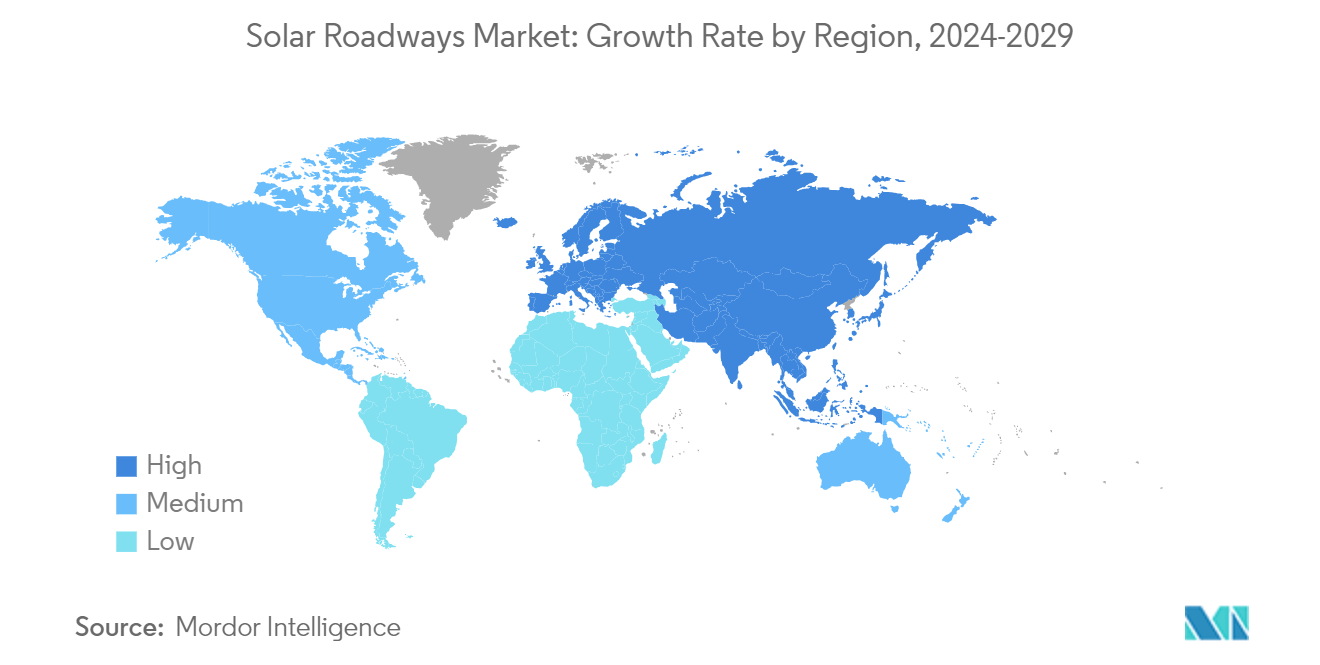Market Trends of Solar Roadways Industry
The Driveways Segment is Expected to Witness Significant Growth
- With the advancement of renewable energy technology, countries around the world are exploring several ways to integrate renewable energy, such as solar energy, on roads and highways. Installing solar panels on roads provides several advantages, like generating green electricity to power street lights and charge electric vehicles.
- There are several studies around the world that estimate the potential of solar energy on roads and rails. For instance, in March 2024, the European Commission's Joint Research Centre (JRC) found 403 GW of solar energy potential, which is estimated to have an annual energy production of around 391 TWh. Such a study is expected to support the segment to have investment for development in the upcoming years.
- Asia-Pacific is home to some of the world's most populous and traffic-congested cities, offering ample opportunities for solar highways to generate electricity and contribute to easing gridlock through smart transportation features, such as intelligent traffic management systems and electric vehicle charging stations integrated into the roads.
- The advancements in solar technology, including improved efficiency and durability of photovoltaic cells, are making solar highways more feasible and cost-effective than ever before. Collaborations between governments, technology companies, and infrastructure developers are driving innovation and scaling up deployment efforts across the region.
- For example, the first solar pavements in Singapore were planned to be installed on Sentosa's Fort Siloso Skywalk in the first quarter of 2024 as part of the island's efforts to achieve carbon neutrality while it explores new ways to harness the power of the sun. Solar pavements are essentially solar panels installed on pavements that pedestrians can walk on. The Sentosa Development Corporation (SDC) has been aggressively rolling out the use of solar panels. It achieved over 5.2 megawatt-peak solar capacity in 2023, surpassing its original 3 megawatt-peak solar capacity target by about 68%. SDC is actively collaborating with its island partners to roll out its solar panel. All these efforts are likely to see an increase in the growth of the solar roadways market in the coming years.
- Therefore, as per the points mentioned above, Asia-Pacific is expected to witness rapid growth during the forecast period.

Asia-Pacific will be the Fastest-Growing Region
- The Asia-Pacific region is witnessing a burgeoning interest and investment in solar highways, driven by the imperative to transition towards sustainable energy sources and mitigate environmental concerns.
- In recent years, the region has been rapidly prioritizing renewable energy initiatives to address energy security and climate change challenges. This has led to significant government support and initiatives related to solar highway projects, fostering a conducive environment for their development. For example, in 2022, as per the Road Transport and Highways Ministry in India, the country has been working on developing electric highways powered by solar energy that will facilitate the charging of heavy-duty trucks and buses. Such efforts will likely help the solar roadways market growth in the region.
- Further, the rapid urbanization and infrastructural expansion in countries like China and India have exacerbated energy demands, making innovative solutions like solar highways attractive for their potential to generate clean electricity while utilizing existing infrastructure.
- Moreover, the region is home to some of the world's most populous and traffic-congested cities, offering ample opportunities for solar highways to generate electricity and contribute to easing gridlock through smart transportation features such as intelligent traffic management systems and electric vehicle charging stations integrated into the roads.
- In addition, the advancements in solar technology, including improved efficiency and durability of photovoltaic cells, are making solar highways more feasible and cost-effective than ever before. Besides, collaborations between governments, technology companies, and infrastructure developers are driving innovation and scaling up deployment efforts across the region.
- For example, the first solar pavements in Singapore were planned to be installed on Sentosa's Fort Siloso Skywalk in the first quarter of 2024 as part of the island's efforts to achieve carbon neutrality while it explores new ways to harness the power of the sun. Solar pavements are essentially solar panels installed on pavements that pedestrians can walk on. Moreover, the Sentosa Development Corporation (SDC) has been aggressively rolling out the use of solar panels. It achieved over 5.2 megawatt-peak solar capacity in 2023, surpassing its original 3 megawatt-peak solar capacity target by about 68%. In addition, SDC is actively collaborating with its island partners to roll out its solar panel. All these efforts are likely to see an increase in the growth of the solar roadways market in the coming years.
- Therefore, as per the points mentioned above, the Asia-Pacific Region is expected to witness rapid growth during the forecast period.


